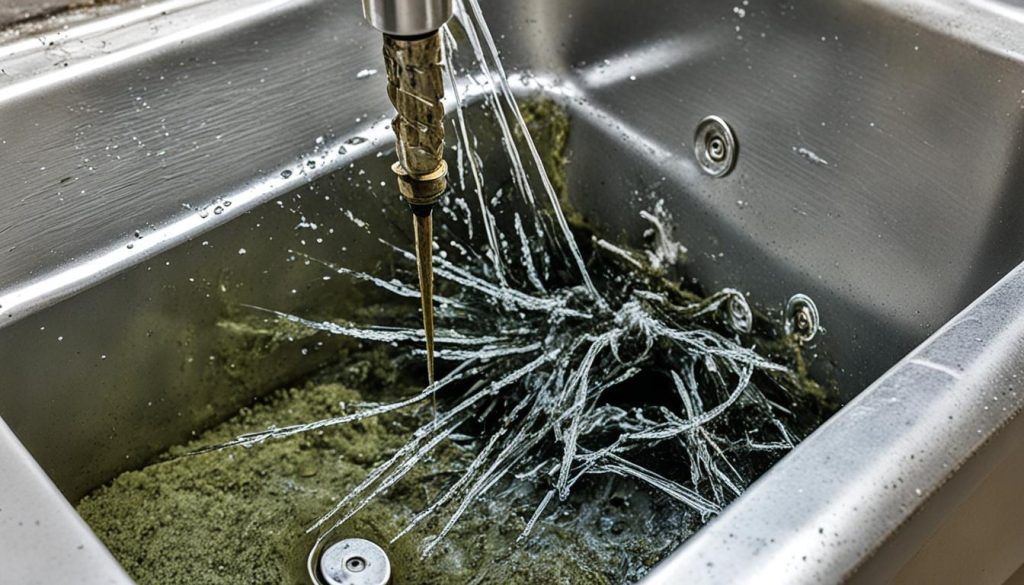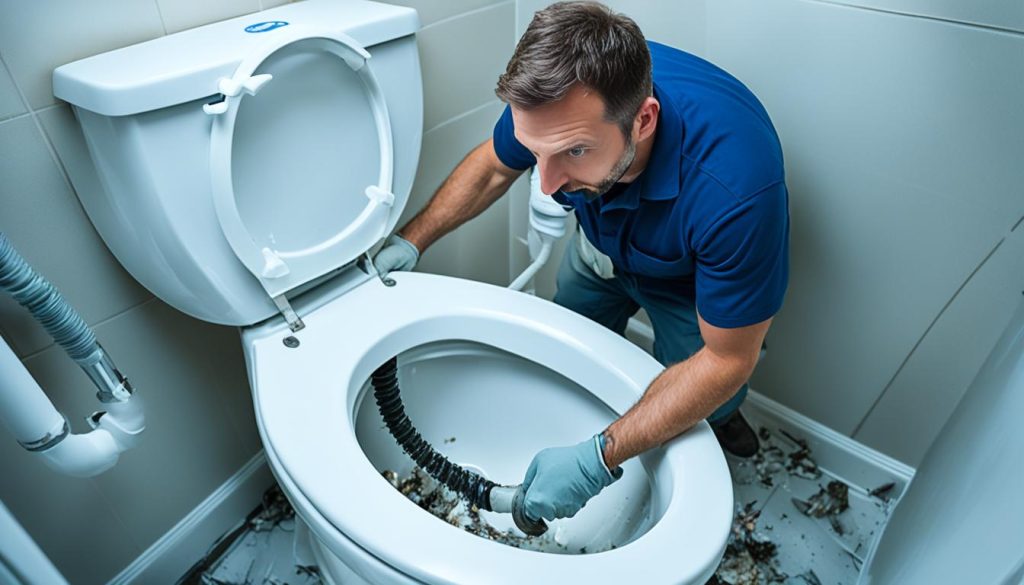Clear Clogs Fast: How to Use a Drain Auger
Did you know that clogged drains are a common household problem that can lead to costly repairs if left untreated? In fact, according to a recent survey, more than 90% of homeowners experience a clogged drain at least once a year. If you’re tired of dealing with slow drains or standing water in your sinks and showers, it’s time to learn how to use a drain auger.
Key Takeaways:
- A drain auger is a versatile plumbing tool used to clear clogs in sinks, showers, and bathtubs.
- There are different types of drain snakes available for different types of clogs.
- Using a drain auger for sink drains involves removing the P-trap, inserting the auger head, and clearing the blockage.
- A closet auger or toilet auger is specifically designed for unclogging toilets.
- When using a drain auger, it’s important to follow proper instructions and take safety precautions.
Types of Drain Snakes and their Uses
When it comes to unclogging drains, using a plumber’s snake, also known as a drain auger, can be a game-changer. These versatile tools come in different types to tackle various types of clogs. Let’s explore the different drain snakes and their specific uses.
1. Handheld Drain Auger (Plumber’s Snake)
The handheld drain auger is a compact and manual tool that features a ¼-inch wire and a hand crank. It is perfect for dealing with minor clogs in sinks and bathtubs. With its small size and flexibility, this type of drain snake allows easy maneuvering through pipes and effectively clears blockages.
2. Heavy-Duty Drain Snakes
For stubborn blockages, heavy-duty drain snakes are the way to go. These drain augers are designed with greater power and durability to tackle more challenging clogs. They can be used for sinks, showers, and bathtubs, providing a reliable solution for tougher obstructions. Some heavy-duty models even come with attachments for additional power from a drill or a built-in motor.
3. Closet Auger (Toilet Auger)
When it comes to dealing with toilet clogs, a closet auger, also known as a toilet auger, is specifically designed for the job. These drain snakes have a protective rubber coating over the coiled wire, preventing any damage to the porcelain. A long rigid tube guides the closet auger into the toilet drain, allowing for effective clearing of blockages without causing any harm.
By choosing the right type of drain snake for the specific clog, you can ensure efficient and effective unclogging of your drains. Whether it’s a handheld drain auger, a heavy-duty model, or a closet auger, these tools are essential for any DIY drain cleaning arsenal.
| Type of Drain Snake | Best for |
|---|---|
| Handheld Drain Auger (Plumber’s Snake) | Minor clogs in sinks and bathtubs |
| Heavy-Duty Drain Snakes | Stubborn blockages in sinks, showers, and bathtubs |
| Closet Auger (Toilet Auger) | Toilet clogs |
Step-by-Step Guide on Using a Drain Auger for Sinks
When it comes to dealing with stubborn sink drain clogs, a drain auger is a powerful tool that can help you clear the blockage quickly and effectively. With a few simple steps, you can use a drain auger to tackle even the most stubborn clogs and restore proper drainage to your sink.
Gather the necessary tools and equipment
Before you begin, make sure you have all the tools and equipment you need. This includes a drain auger, also known as a drain snake, a bucket to catch any water, and any necessary safety gear such as rubber gloves and safety goggles.
Prepare the area
To avoid making a mess, place a bucket underneath the sink to catch any water that may spill out during the process. This will help keep your work area clean and make cleanup easier.
Remove the P-trap
The first step in using a drain auger for sink drain clogs is to remove the P-trap, which is the curved pipe under the sink. This can usually be done by loosening and removing the slip nuts that hold the P-trap in place. Be sure to have a bucket handy to catch any water that may be trapped in the P-trap.
Insert the drain auger
Once the P-trap is removed, insert the auger head into the drain or pipe opening. Push the coiled wire of the drain auger into the pipe while turning the crank to navigate through the pipe. The flexible wire will work its way through the pipe, breaking up and removing any clogs or obstructions in its path.
Clear the clog
Continue pushing and turning the auger until you reach the clog or obstruction. If the wire gets stuck, turn the drum in reverse while slowly backing the cable out. This will help dislodge any debris and allow you to continue clearing the clog.
Remove the debris
Once you have reached the end of the cable, gently pull it out of the drain. As you pull the cable out, you may notice that it is covered in debris or clog material. Remove any debris or clog that came up with the cable and dispose of it properly. This will help prevent future clogs and ensure proper drainage.
Reassemble and test
Finally, reassemble the drainage pipe by tightening the slip nuts and ensuring a secure connection. Once everything is back in place, test the sink by running hot water to ensure that the clog has been completely cleared. If the water drains smoothly without any signs of a clog, you have successfully used a drain auger to clear your sink drain.
Step-by-Step Guide on Using a Closet Auger for Toilets
When dealing with a clogged toilet, using a toilet auger, also known as a closet auger, is the most effective solution. Follow these steps to unclog a toilet with an auger:
- Step 1: Ensure your safety by wearing rubber gloves and safety goggles.
- Step 2: Guide the toilet auger cable into position by fully extending the handle and pulling the corkscrew end up to the mouth of the tube.
- Step 3: Insert the curved end of the auger into the toilet drain, making sure it goes as far as possible.
- Step 4: Crank the auger by turning the handle while applying downward pressure, allowing the coiled wire to work through the toilet drain and clear the blockage.
- Step 5: If the blockage persists, continue cranking the wire until it is fully extended, ensuring that the auger reaches as far as possible down the drain.
- Step 6: Finally, carefully pull the coiled wire out of the toilet, checking for any objects that may have come up with it. Dispose of any debris properly. Don’t forget to flush to see if the blockage is completely gone.
- Step 7: Repeat the process if necessary to ensure the toilet is thoroughly unclogged.
Using a closet auger for toilets is a straightforward process that can save you from the hassle and cost of calling a plumber. Give it a try before seeking professional help!
Tips for Safe and Effective Use of a Drain Auger
When using a drain auger, it is important to prioritize safety and follow the proper instructions. To protect yourself, always wear rubber gloves and safety goggles throughout the process. These precautions will shield your hands and eyes from any potential harm. Remember, prevention is the key.
Avoid using drain cleaners or any other chemicals while snaking the drain. Chemicals can react unpredictably, causing potential hazards or damaging the plumbing system. Instead, rely solely on the drain auger to tackle the clog effectively.
Hold the drain auger firmly and exercise caution while turning the crank. This will ensure smooth operation and prevent accidents. In case the snake becomes stuck, remain calm and avoid exerting excessive force. For retrieval, carefully turn the drum in reverse to retrieve the cable with ease.
If you don’t already have a drain auger at home, consider renting one from a reputable home improvement retailer. This way, you can save both money and storage space, while still having the necessary tool available when needed.
It is also important to note that while a drain auger is a versatile plumbing tool, it may not be suitable for all scenarios. For example, dealing with tree root blockages or fragile pipes should be left to the expertise of professional plumbers. They have the necessary skills and equipment to handle such situations, ensuring the best possible outcome for your plumbing system.
- Investing Wisely: How Windows & Doors in Boost Property Value and Financial Health - April 24, 2025
- The Financial Impact of Personal Injuries: Why Legal Help Matters for Business Owners - April 16, 2025
- The Hidden Financial Costs of Domestic Assault: What Business Owners Need to Know - April 16, 2025














